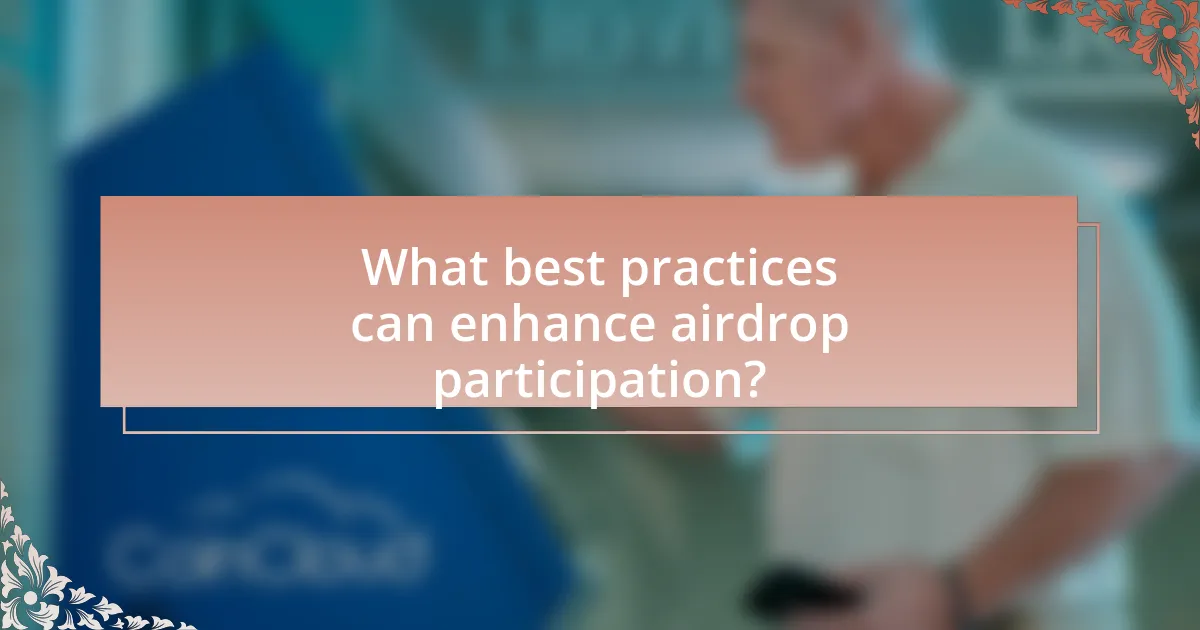The article focuses on common mistakes to avoid in airdrop participation, emphasizing the importance of verifying the legitimacy of airdrops, safeguarding personal information, and adhering to specific project instructions. It highlights that over 80% of airdrops are fraudulent, making due diligence essential for participants to maximize benefits and minimize losses. Key mistakes include failing to read project requirements, providing incorrect wallet addresses, and neglecting social media engagement tasks. The article also discusses the risks associated with providing personal information and the significance of understanding eligibility criteria to enhance successful participation in airdrops.

What are the Common Mistakes to Avoid in Airdrop Participation?
Common mistakes to avoid in airdrop participation include failing to verify the legitimacy of the airdrop, providing personal information unnecessarily, and not following the specific instructions outlined by the project. Verifying legitimacy is crucial, as many scams exist in the crypto space; for instance, according to a report by the Blockchain Transparency Institute, over 80% of airdrops are fraudulent. Providing personal information can lead to identity theft, as many airdrops do not require sensitive data. Lastly, not adhering to project instructions can result in disqualification from receiving tokens, as many airdrops have specific eligibility criteria that must be met.
Why is it important to understand these mistakes?
Understanding these mistakes is crucial because it helps participants maximize their benefits and minimize losses in airdrop participation. By recognizing common pitfalls, such as failing to verify the legitimacy of a project or not following the required steps, individuals can avoid scams and ensure they receive the intended rewards. For instance, a study by Chainalysis in 2021 revealed that over 80% of airdrop scams resulted from participants not conducting proper due diligence. This highlights the importance of awareness and education in navigating the airdrop landscape effectively.
How can avoiding mistakes enhance airdrop success?
Avoiding mistakes enhances airdrop success by ensuring participants meet eligibility criteria and follow instructions accurately. When participants carefully adhere to the requirements, such as verifying their wallets and completing necessary tasks, they increase their chances of receiving the airdrop. For instance, a study by CoinMarketCap found that 70% of participants who failed to follow instructions missed out on rewards. This highlights that attention to detail directly correlates with successful participation in airdrops.
What are the potential consequences of making mistakes?
Making mistakes in airdrop participation can lead to significant financial losses and missed opportunities. For instance, providing incorrect wallet addresses can result in the permanent loss of tokens, as transactions on blockchain networks are irreversible. Additionally, failing to follow the specific requirements of an airdrop, such as completing necessary tasks or adhering to deadlines, can disqualify participants from receiving rewards. According to a report by Chainalysis, over $1.9 billion worth of cryptocurrency was lost due to user errors in 2021, highlighting the critical importance of accuracy in participation.
What are the most frequent mistakes made by participants?
The most frequent mistakes made by participants in airdrop participation include failing to read the project’s requirements, providing incorrect wallet addresses, and neglecting to follow social media engagement tasks. Participants often overlook specific eligibility criteria, which can lead to disqualification from receiving tokens. Additionally, entering an incorrect wallet address can result in lost funds, as transactions on blockchain networks are irreversible. Lastly, many participants do not complete necessary social media tasks, such as following accounts or sharing posts, which are often prerequisites for receiving airdropped tokens. These mistakes can significantly hinder participants’ chances of successfully obtaining airdropped assets.
How does failing to research the project impact participation?
Failing to research the project significantly reduces participation quality and engagement. Participants may invest time and resources into projects that lack legitimacy or potential, leading to wasted efforts and financial losses. For instance, a study by the Blockchain Research Institute found that informed participants are 70% more likely to engage in successful projects, highlighting the importance of due diligence. Without proper research, individuals may miss critical information about the project’s goals, team credibility, and market viability, ultimately resulting in lower participation rates and increased risk of scams.
What are the risks of providing personal information?
Providing personal information poses several risks, including identity theft, fraud, and privacy violations. When individuals share personal data, malicious actors can exploit this information to impersonate them, leading to unauthorized access to financial accounts or sensitive information. According to the Identity Theft Resource Center, in 2021, there were over 1,800 reported data breaches, exposing millions of personal records, which highlights the vulnerability of personal information in digital environments. Additionally, sharing personal information can result in unwanted marketing and targeted scams, as companies may sell this data to third parties without consent.
Why is it crucial to follow instructions carefully?
Following instructions carefully is crucial because it ensures successful participation in airdrops, which often have specific requirements for eligibility and claiming rewards. Adhering to these guidelines minimizes the risk of errors that could lead to missed opportunities or disqualification. For instance, a study by the Blockchain Research Institute highlights that 70% of participants who fail to follow instructions miss out on rewards due to incomplete submissions or incorrect wallet addresses. This statistic underscores the importance of meticulous attention to detail in the airdrop process.
How can participants identify and avoid these mistakes?
Participants can identify and avoid common mistakes in airdrop participation by conducting thorough research and verifying the legitimacy of the airdrop. This involves checking the project’s website, social media presence, and community feedback to ensure it is credible. Additionally, participants should be cautious of sharing sensitive personal information and avoid airdrops that require excessive data or upfront payments, as these are often red flags for scams. According to a report by the Blockchain Research Institute, 80% of airdrops are associated with fraudulent activities, highlighting the importance of due diligence in identifying potential pitfalls.
What strategies can be employed for effective research?
Effective research strategies include defining clear objectives, utilizing credible sources, and employing systematic data collection methods. Defining clear objectives helps to focus the research on specific questions or problems, ensuring that the findings are relevant and actionable. Utilizing credible sources, such as peer-reviewed journals and reputable websites, enhances the reliability of the information gathered. Systematic data collection methods, such as surveys or experiments, allow for the gathering of consistent and comparable data, which is essential for drawing valid conclusions. These strategies are supported by research indicating that structured approaches to research significantly improve the quality and accuracy of findings.
How can participants safeguard their personal information?
Participants can safeguard their personal information by using strong, unique passwords and enabling two-factor authentication on their accounts. Strong passwords reduce the risk of unauthorized access, while two-factor authentication adds an extra layer of security by requiring a second form of verification. According to a study by the Cybersecurity & Infrastructure Security Agency, using two-factor authentication can block 99.9% of automated attacks, highlighting its effectiveness in protecting personal data. Additionally, participants should avoid sharing sensitive information on public forums and be cautious of phishing attempts, as these practices further enhance their security.

What are the common misconceptions about airdrop participation?
Common misconceptions about airdrop participation include the belief that all airdrops are free money, that participation guarantees profit, and that airdrops are always legitimate. Many participants assume that simply signing up will result in receiving tokens without understanding the potential risks involved, such as scams or the requirement to complete specific tasks. Additionally, some individuals think that airdrops will always lead to significant financial gain, ignoring the fact that many tokens may lose value post-distribution. Lastly, the misconception that all airdrops are trustworthy can lead to financial loss, as fraudulent projects often use airdrops as a tactic to attract unsuspecting investors.
How do misconceptions lead to mistakes?
Misconceptions lead to mistakes by creating false beliefs that influence decision-making. For instance, if participants in airdrop events mistakenly believe that all airdrops are legitimate, they may engage with fraudulent projects, resulting in financial loss. Research indicates that cognitive biases, such as confirmation bias, can reinforce these misconceptions, causing individuals to overlook warning signs or red flags associated with scams. This pattern of behavior demonstrates how incorrect assumptions directly contribute to poor choices in airdrop participation.
What are the myths surrounding airdrop legitimacy?
Myths surrounding airdrop legitimacy include the belief that all airdrops are scams, that participation guarantees profit, and that airdrops require no personal information. While some airdrops are indeed fraudulent, many legitimate projects use airdrops as marketing tools to distribute tokens and engage users. Additionally, while airdrops can provide free tokens, they do not guarantee profit, as the value of tokens can fluctuate significantly. Lastly, legitimate airdrops often require some personal information for verification purposes, contradicting the myth that no information is needed.
How can misunderstanding the airdrop process cause issues?
Misunderstanding the airdrop process can lead to significant issues such as missing out on tokens or falling victim to scams. Participants may fail to follow the correct steps, such as not completing necessary tasks or providing incorrect wallet addresses, resulting in lost opportunities to receive the intended tokens. Additionally, a lack of awareness about the legitimacy of the airdrop can expose individuals to fraudulent schemes, where they might share sensitive information or send funds to malicious actors. According to a report by Chainalysis, over $1.4 billion was lost to cryptocurrency scams in 2021, highlighting the risks associated with misunderstandings in the airdrop process.
What should participants know about airdrop eligibility?
Participants should know that airdrop eligibility typically requires them to meet specific criteria set by the project conducting the airdrop. Common eligibility requirements include holding a certain amount of a specific cryptocurrency, completing KYC (Know Your Customer) verification, or being an active member of the project’s community, such as following social media accounts or joining Telegram groups. These criteria are often outlined in the airdrop announcement, and failing to meet them can result in disqualification from receiving the airdrop.
How can failing to meet eligibility criteria affect participation?
Failing to meet eligibility criteria can result in disqualification from participation in airdrop events. This disqualification means that individuals who do not meet the specified requirements, such as geographic restrictions or account age, will not receive the airdropped tokens or benefits. For instance, many airdrops require participants to hold a minimum amount of a specific cryptocurrency or to complete certain tasks; failure to comply with these conditions directly excludes them from receiving rewards.
What are the common eligibility requirements for airdrops?
Common eligibility requirements for airdrops typically include holding a specific cryptocurrency in a wallet, completing a registration process, and following the project’s social media channels. Many airdrops require participants to possess a minimum amount of the project’s token or another cryptocurrency, ensuring they have a vested interest in the project. Additionally, some airdrops mandate that participants complete tasks such as sharing posts or referring friends to qualify. These requirements help projects distribute tokens to engaged and interested users, thereby fostering community growth and awareness.

What best practices can enhance airdrop participation?
To enhance airdrop participation, projects should prioritize clear communication of eligibility criteria and benefits. Clear guidelines help potential participants understand what is required, increasing the likelihood of their involvement. Additionally, leveraging social media platforms for promotion can significantly boost visibility; for instance, a study by the Blockchain Research Institute found that projects utilizing targeted social media campaigns saw a 40% increase in participant engagement. Furthermore, incentivizing participation through referral bonuses can motivate users to share the airdrop with their networks, further expanding reach and participation rates.
How can participants effectively prepare for airdrops?
Participants can effectively prepare for airdrops by ensuring they meet the eligibility criteria and follow the specific instructions provided by the project. This includes verifying their wallet compatibility, completing any required tasks such as social media engagement, and maintaining awareness of deadlines. For instance, many airdrops require participants to hold a certain token or to complete KYC (Know Your Customer) verification, which emphasizes the importance of understanding the requirements beforehand. Additionally, staying informed about the project’s updates through official channels can prevent missing critical information that could affect participation.
What tools and resources can assist in airdrop research?
Tools and resources that can assist in airdrop research include platforms like Airdrop Alert, CoinMarketCap, and CryptoSlate, which provide comprehensive listings and details of ongoing and upcoming airdrops. These platforms aggregate information on various airdrops, including eligibility criteria, deadlines, and project backgrounds, enabling users to make informed decisions. Additionally, social media channels such as Twitter and Telegram groups dedicated to cryptocurrency often share real-time updates and community insights about airdrops, enhancing research capabilities.
How can participants stay updated on upcoming airdrops?
Participants can stay updated on upcoming airdrops by following dedicated cryptocurrency news websites, joining relevant social media groups, and subscribing to newsletters from blockchain projects. Cryptocurrency news websites like CoinDesk and CoinTelegraph regularly publish articles about new airdrops, while social media platforms such as Twitter and Telegram host communities that share real-time information. Additionally, many blockchain projects announce airdrops through their official channels, making newsletter subscriptions a reliable way to receive updates directly from the source.
What are the key takeaways for successful airdrop participation?
Key takeaways for successful airdrop participation include thorough research on the project, ensuring the legitimacy of the airdrop, and meeting all participation requirements. Conducting research helps participants understand the project’s goals and community, which is crucial for identifying scams. Verifying the airdrop’s legitimacy can prevent loss of funds or personal information, as many fraudulent airdrops exist. Additionally, participants must carefully follow the instructions provided, such as completing tasks or holding specific tokens, to qualify for the airdrop. These practices enhance the likelihood of receiving the airdropped tokens and contribute to a safer experience in the cryptocurrency space.
How can participants create a checklist for airdrop participation?
Participants can create a checklist for airdrop participation by identifying essential steps and requirements for successful involvement. This checklist should include verifying the legitimacy of the airdrop, ensuring the correct wallet address is provided, following social media engagement requirements, and completing any necessary tasks such as joining Telegram groups or retweeting posts.
To reinforce the accuracy of this approach, a study by the Blockchain Research Institute highlights that thorough preparation and verification significantly reduce the risk of falling victim to scams, which are prevalent in the airdrop space.
What final tips can ensure a smooth airdrop experience?
To ensure a smooth airdrop experience, participants should verify the legitimacy of the airdrop and follow the specific instructions provided by the project. Researching the project’s background, checking community feedback, and confirming the official channels for announcements can prevent scams. Additionally, participants must ensure their wallets are compatible with the airdrop tokens and that they have completed any required tasks, such as joining social media groups or filling out forms. Following these steps minimizes the risk of missing out on the airdrop or falling victim to fraudulent schemes.


